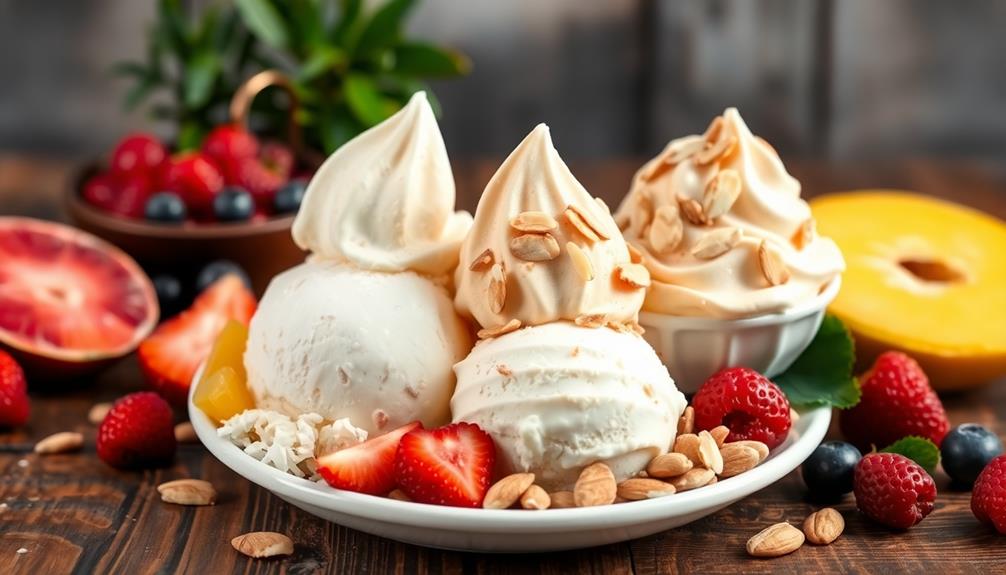Ice cream bases like dairy, coconut, and almond each pack unique nutritional benefits. Dairy ice cream offers a creamy texture with protein and calcium, though it can be high in saturated fat and sugar. Coconut ice cream supplies quick energy from healthy fats but also raises heart health concerns due to its saturated fat content. Almond ice cream stands out as a lower-calorie option, yet it has less protein and nutrients. By understanding these differences, you can make informed choices that suit your dietary needs. Keep exploring to discover tips for choosing the healthiest options!
Key Takeaways
- Dairy ice cream is rich in calcium and protein but high in saturated fat and sugar, averaging 25 grams of sugar per scoop.
- Coconut ice cream contains medium-chain triglycerides (MCTs) for quick energy but has high saturated fat levels, raising heart health concerns.
- Almond ice cream is a lower-calorie option with less saturated fat but offers lower protein content compared to dairy ice cream.
- Soy milk ice cream provides higher protein content but may lack essential nutrients found in other bases, like calcium and vitamins.
- Monitoring sugar intake is crucial, as all ice cream types can contain significant added sugars, impacting overall health.
Overview of Ice Cream Bases

When it comes to ice cream bases, you'll find a variety of options that cater to different tastes and dietary needs.
Dairy ice cream stands out with its creamy texture, containing at least 10% milkfat. This base not only delivers a rich flavor but also packs a protein punch, averaging 25 grams of sugar per scoop, which is close to the daily limit for women.
On the other hand, coconut milk ice cream is a popular choice for those who enjoy a rich taste. However, be mindful that it's high in saturated fats, often around 90%, and can reach around 250 calories per serving, making it a denser treat.
If you're looking for something lighter, almond milk ice cream offers an alternative, averaging 250 calories with about 12 grams of fat and 23 grams of sugars. Just remember, it may contain minimal actual almonds, primarily diluted in water.
Lastly, soy milk ice cream strikes a balance, providing roughly 240 calories, 12 grams of fat, and 17 grams of sugars per serving.
Each base brings unique nutritional content, so choose based on your preferences and dietary goals!
Nutritional Profile of Dairy

Dairy ice cream offers a rich nutritional profile that appeals to many ice cream lovers. With a minimum of 10% milkfat, it provides a creamy texture and delightful flavor. However, it's important to be aware of its nutritional components.
Here's a quick overview of the key nutrients found in a standard serving (about 1/2 cup):
| Nutrient | Amount per Serving | Health Benefits |
|---|---|---|
| Calories | 150-250 | Provides energy |
| Protein | 3-5 grams | Supports muscle repair and growth |
| Calcium | Varies | Essential for bone health |
| Saturated Fat | 8-15 grams | Can impact heart health if consumed excessively |
Dairy ice cream also contains essential vitamins like vitamin D and B12, which enhance overall nutrition. While it's a great source of protein and calcium, be mindful of the high saturated fat content. Enjoying dairy ice cream in moderation allows you to benefit from its nutritional advantages while keeping your heart health in check. So go ahead, indulge in your favorite flavor, but remember to balance it with other healthy choices!
Benefits of Coconut Ice Cream
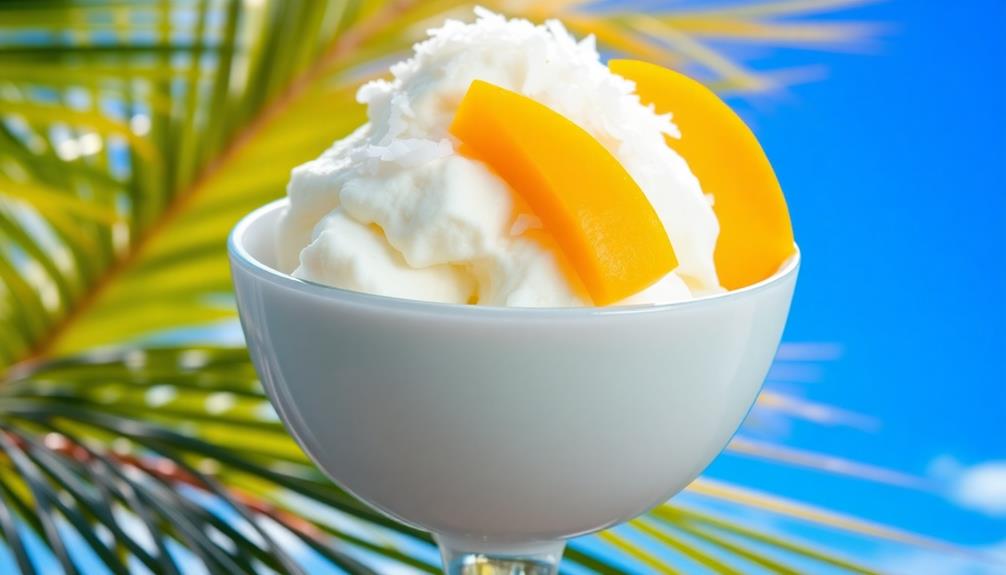
Coconut ice cream offers a unique nutritional profile that sets it apart from traditional dairy options.
You'll find it packed with medium-chain triglycerides (MCTs) and beneficial lauric acid, both of which can support your health.
Plus, with minimal ingredients and a delicious creamy texture, it's a great choice for those looking for a satisfying, dairy-free treat.
Nutritional Profile Overview
Often overlooked in the sphere of frozen treats, coconut ice cream offers a unique nutritional profile that caters to various dietary needs. If you're looking for a non-dairy ice cream option, coconut ice cream stands out with its creamy texture, primarily derived from coconut milk. It contains about 250 calories per 2/3 cup serving, making it calorie-dense but a satisfying treat.
One of the highlights of coconut ice cream is its rich content of healthy fats. With around 18g of saturated fat per serving, it's important to enjoy it in moderation. The saturated fat in coconut can raise cholesterol levels, but it also provides a source of medium-chain triglycerides (MCTs), which might offer quick energy and support metabolism.
Additionally, many brands take advantage of coconut's natural sweetness, which often results in lower added sugar content compared to other ice creams. This can be beneficial if you're trying to maintain a lower sugar intake.
Plus, since it's lactose-free, it's a great choice for those with lactose intolerance or anyone following a vegan diet. Overall, coconut ice cream presents a deliciously unique option in the sphere of frozen desserts.
Health Benefits Explained
When you indulge in coconut ice cream, you're not just treating your taste buds; you're also reaping several health benefits. This creamy delight is naturally lactose-free, making it an excellent choice if you have lactose intolerance or a dairy allergy. You can enjoy the rich flavor without the discomfort that dairy might cause.
Coconut ice cream's high fat content comes from coconut milk, primarily made up of saturated fat. While it's important to monitor portion sizes—typically around 250 calories and 18g of saturated fat per serving—this fat is largely composed of medium-chain triglycerides (MCTs). MCTs may support weight management and provide a quick source of energy, setting coconut ice cream apart from traditional options.
Moreover, coconut ice cream offers nutritional benefits by being free from artificial ingredients and preservatives. This means you can indulge in a treat while reducing your intake of harmful chemicals, making it a more wholesome choice.
Environmental Impact Considerations
Many people don't realize that choosing coconut ice cream can be a more sustainable option for the environment. When you opt for this delicious treat, you're not just indulging; you're also making a choice that benefits the planet.
Here are some key environmental impacts of coconut ice cream:
- Water Conservation: Coconut ice cream production requires considerably less water compared to dairy options, making it ideal for environmentally conscious consumers.
- Lower Greenhouse Gas Emissions: Cultivating coconut palms helps sequester carbon, contributing to reduced greenhouse gas emissions.
- Organic Ingredients: Many coconut ice creams are made with organic and Non-GMO ingredients, promoting biodiversity and minimizing pesticide use.
- Support for Plant-Based Diets: By choosing coconut ice cream, you're reducing reliance on animal agriculture, which is linked to high methane emissions and land degradation.
Almond Ice Cream Nutrition
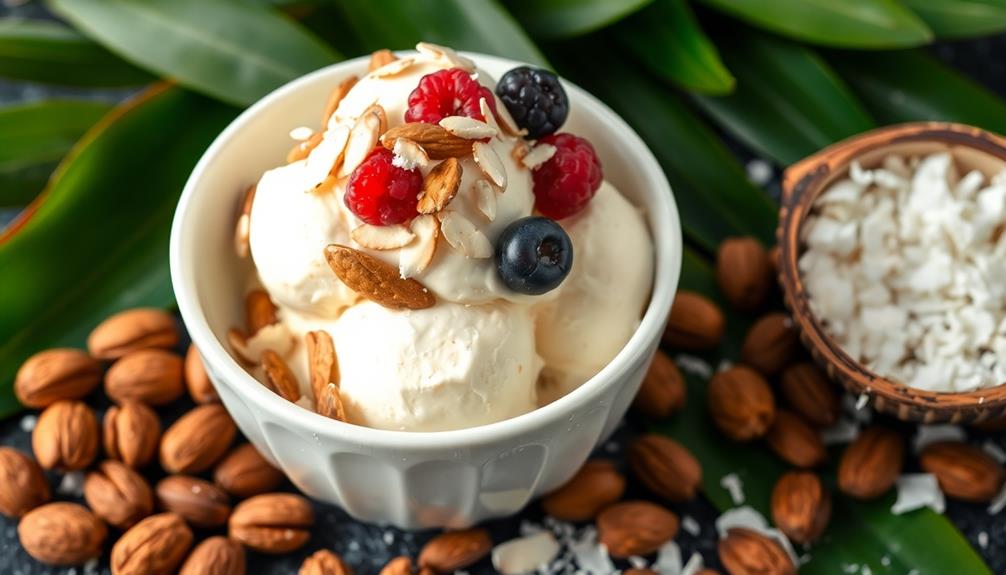
Almond ice cream provides a delicious alternative to traditional dairy options, especially for those seeking a lower-calorie treat. With around 250 calories per serving, it's a lower-calorie option that satisfies your sweet tooth without the guilt.
This ice cream typically contains 12 grams of fat, primarily from almonds, which means you're getting healthy fats that can support your cardiovascular health.
While almond ice cream is lower in protein than its dairy counterparts, its nutritional profile makes it appealing for many. It's also lower in saturated fat compared to coconut milk ice cream, making it a smart choice if you're monitoring your saturated fat intake.
Plus, being dairy-free, almond ice cream is suitable for individuals with lactose intolerance, allowing you to indulge without worrying about digestive issues.
However, be mindful that many almond ice creams contain minimal actual almonds and often rely on water and additives. Always check the ingredient labels to verify you're choosing a quality product.
Comparison of Sugar Content
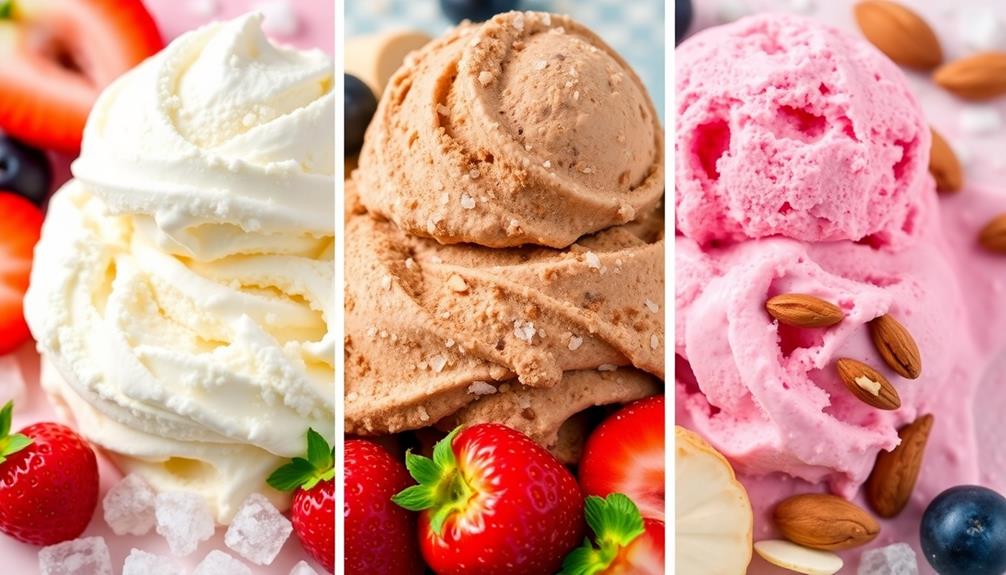
Ice cream lovers should pay close attention to sugar content, as it varies noticeably among different types. Understanding how much sugar per serving can help you make more informed choices.
Here's a quick comparison of sugar levels in popular ice cream bases:
- Dairy Ice Cream: Typically contains around 25 grams of sugar per scoop, which hits the daily limit for women. This can lead to excessive sugar intake if you're not careful.
- Coconut Milk Ice Cream: Often has high sugar content, averaging about 23 grams of sugar per serving. This considerably adds to its calorie count.
- Almond Milk Ice Cream: Similar to coconut varieties, it generally contains about 23 grams of sugar, but the almond content is often minimal, relying heavily on water and sweeteners.
- Non-Dairy Frozen Desserts: Options like soy and oat milk ice cream can exceed 10 grams of sugar per serving. An alarming 90% of these non-dairy frozen desserts show high sugar levels, making label reading essential.
Saturated Fat Levels Explained
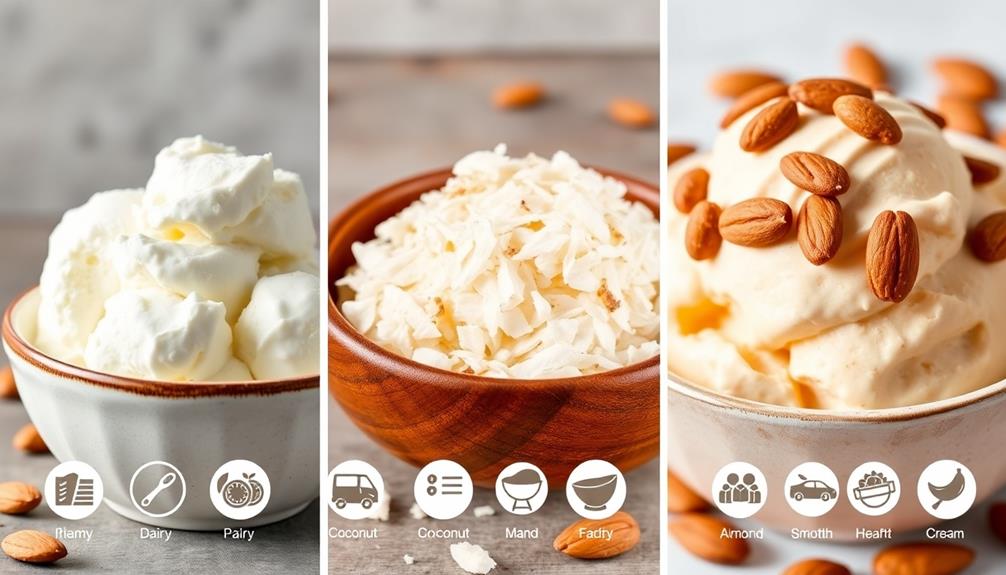
When it comes to ice cream, understanding saturated fat levels is essential for your heart health.
You'll find that different bases, like dairy and coconut, can pack a hefty amount of saturated fat, while almond and oat milk options are typically lighter.
It's important to keep daily recommended limits in mind to make healthier choices.
Impact on Heart Health
Understanding the impact of saturated fat on heart health is vital, especially since many popular ice cream bases can contain significant amounts.
High saturated fat intake can lead to increased cholesterol levels and potential heart health risks. Here's a breakdown of how different ice cream bases stack up:
- Dairy Ice Cream: Typically contains a high level of saturated fat due to its milkfat content, often exceeding the American Heart Association's recommendation.
- Coconut-Based Ice Creams: Known for their rich texture, these options can have around 18g of saturated fat per serving, raising concerns for your heart health.
- Almond Milk Ice Cream: Generally a heart-healthier choice, this ice cream often contains about 1g of saturated fat per serving, making it a better option for those monitoring their intake.
- Ingredient Awareness: It's important to read labels and choose wisely, especially when indulging in richer flavors that could counteract the benefits of a plant-based diet.
Comparison of Sources
Heart health concerns often lead consumers to scrutinize saturated fat levels in various ice cream bases. When it comes to dairy products, traditional ice cream typically contains about 10% milkfat, which contributes to its rich creaminess but also packs a punch with over 15g of saturated fat per serving.
In contrast, coconut milk ice cream can be even more intimidating, with some brands hitting around 18g of saturated fat in just 2/3 cup—a considerable concern for those monitoring their heart health.
On the other hand, almond milk ice cream usually averages 12g of saturated fat per serving, but be cautious; it may contain only minimal actual almonds, potentially compromising its nutritional value.
Similarly, soy milk ice cream offers a moderate option with about 12g of fat, although its protein content can fall short compared to whole soy foods.
The variability in saturated fat levels among plant-based milks highlights the need to examine ingredient sourcing carefully. Many non-dairy options, particularly those with added sugars, can rely heavily on coconut and palm oils, which can greatly bump up fat content.
Daily Recommended Limits
In order to maintain heart health and overall well-being, it's crucial to be mindful of your saturated fat intake. The American Heart Association recommends keeping saturated fat to less than 6% of your total daily calories, which is about 13 grams for a 2,000-calorie diet.
Regular ice cream often contains high levels of saturated fat, with some varieties exceeding 18 grams per serving. Here are some key points to reflect on:
- Regular ice cream: Typically high in saturated fat; frequent consumption can exceed daily limits.
- Coconut milk ice cream: Often contains around 90% saturated fat, potentially impacting heart health if consumed excessively.
- Almond milk ice cream: Generally lower in saturated fat, averaging around 1-5 grams per serving, making it a heart-healthy alternative.
- Plant-based options: Ice creams made from lower-fat bases, like oat or almond, help you manage your saturated fat intake while still enjoying desserts.
Protein Sources in Ice Cream
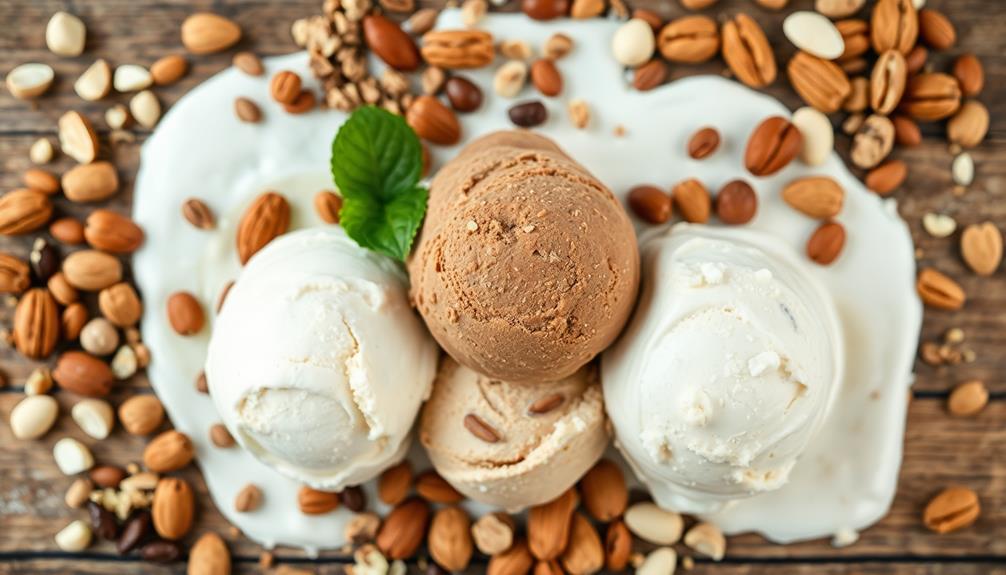
Ice cream can be a tasty treat that also delivers varying levels of protein, depending on its base ingredients. If you enjoy traditional dairy ice cream, you'll find that it typically contains around 4-5 grams of protein per half-cup serving. This comes from the milk, providing a complete source of protein with essential amino acids.
On the other hand, if you opt for almond-based ice creams, you might notice a lower protein content, averaging about 1-2 grams per half-cup. This is primarily due to the minimal almond content.
Coconut milk ice cream is even less protein-rich, offering around 1 gram or less, as it mainly consists of coconut cream.
For those looking for a protein boost in dairy-free ice cream, consider soy-based options. These typically have a higher protein content, averaging 3-5 grams per half-cup, making them a great choice for plant-based protein.
Additionally, some non-dairy frozen desserts incorporate added proteins, such as pea protein, which can enhance the protein content to 4 grams or more per serving, rivaling traditional dairy options.
Health Considerations for Each Base

When choosing an ice cream base, it's essential to take into account the health implications of each option. Each type comes with its unique set of health benefits and considerations that can impact your overall well-being.
- Dairy Ice Cream: This option is typically high in saturated fat and sugar, with one scoop averaging around 25 grams of sugar, which can exceed the daily limit for women.
- Coconut Milk: Ice creams made from coconut milk can be high in saturated fat, with some brands containing up to 18 grams of saturated fat per serving, raising concerns for heart health.
- Almond Milk: Generally lower in calories and fat, almond milk ice cream often contains minimal almonds, primarily being water, which can dilute its nutritional value.
- Soy Milk: While soy milk ice cream offers a better protein profile, it still may lack the overall nutritional content you'd find in whole soy foods.
As you navigate your options, remember to read labels carefully. This way, you can make informed choices that align with your health goals while enjoying your sweet treat!
Environmental Impact of Ingredients
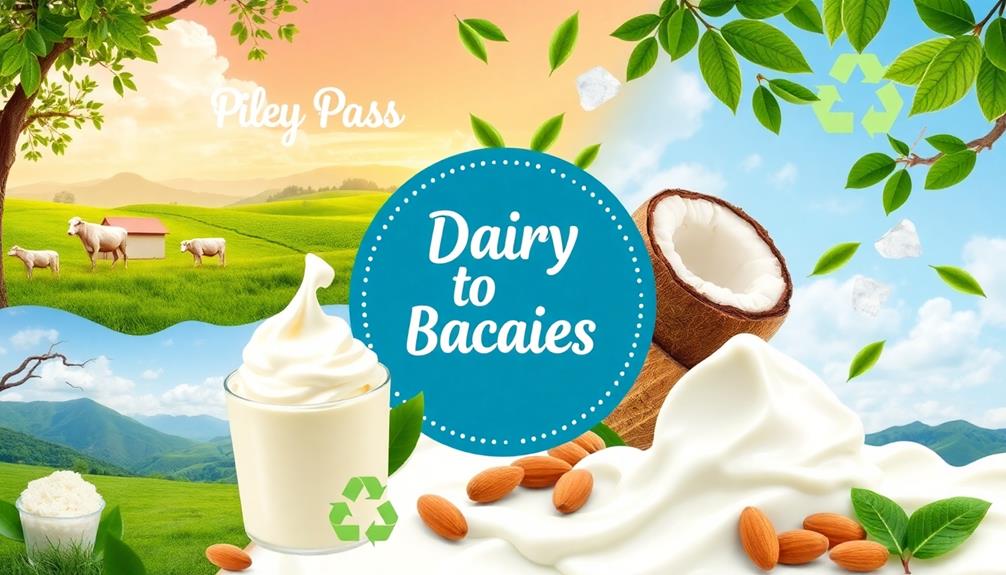
When you choose ice cream bases, consider where the ingredients come from and how they're produced.
Coconut and oat options often have better sourcing practices and contribute positively to biodiversity.
In contrast, dairy ice cream's carbon footprint and resource demands can raise sustainability concerns.
Ingredient Sourcing Practices
Ingredient sourcing practices play an essential role in determining the environmental impact of ice cream bases. When you choose your ice cream, understanding where the ingredients come from is vital. Sustainable sourcing can greatly reduce the negative effects associated with conventional farming.
Here are some key considerations:
- Coconut Ingredients: Often sourced from monoculture plantations, which can lead to biodiversity loss and habitat destruction.
- Almond Farming: Primarily in California, it requires excessive water, with one almond needing about a gallon of water, raising sustainability concerns in drought-prone areas.
- Dairy Farming: Contributes to high greenhouse gas emissions, as dairy cows produce methane, a potent greenhouse gas that worsens climate change.
- Palm Oil Usage: Frequently linked to deforestation and habitat destruction, so it's wise to seek ice cream brands that avoid palm oil or use sustainably sourced alternatives.
Carbon Footprint Comparison
The carbon footprint of ice cream bases varies considerably depending on their ingredients. Dairy ice cream production generates significant greenhouse gas emissions, primarily due to methane released by dairy cows. This potent greenhouse gas contributes heavily to climate change.
On the other hand, coconut milk offers a creamy texture but often requires substantial water and land resources, leading to concerns about deforestation and habitat loss in tropical regions.
Almond-based ice creams present their own sustainability challenges, particularly in California, where almond production has a high water footprint—around 1.1 gallons of water for each almond. This is especially concerning in light of ongoing drought conditions.
In contrast, plant-based ice creams, like those made from oat milk, typically have a lower carbon footprint. Oats require less water and land to grow, making them a more sustainable option.
Resource Utilization Efficiency
Choosing ice cream bases involves considering not just taste but also the environmental impact of their ingredients.
Understanding resource utilization efficiency can guide you in making more sustainable choices. Here's how different bases stack up:
- Dairy Ice Cream: This option demands significant water and land resources, leading to higher greenhouse gas emissions, making it less environmentally friendly.
- Coconut Milk: While it uses less water than dairy, coconut cultivation can result in deforestation and biodiversity loss if not sourced sustainably.
- Almond Milk: Although popular, almond milk has a substantial water footprint—about 1.1 gallons per almond—raising environmental concerns, especially in drought-prone areas.
- Oat Milk: This base stands out for its lower environmental impact.
It requires less water and land than both dairy and almond milk, making it a more sustainable choice for non-dairy ice creams.
Tips for Healthier Choices
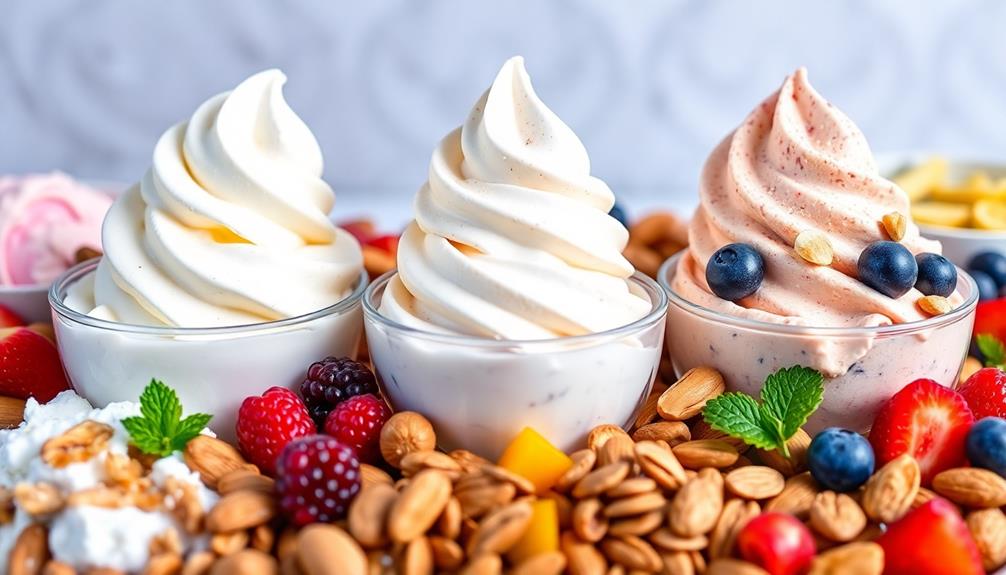
Making healthier choices when it comes to ice cream can be both enjoyable and rewarding. Start by selecting almond milk ice cream, which is lower in calories, typically around 250 calories per serving. This option is a great alternative to coconut milk ice cream, which can hit 250 calories and 18g of saturated fat per 2/3 cup.
Next, look for ice creams that use natural sweeteners like dates or agave syrup. These options reduce added sugars and provide extra nutrients compared to traditional high fructose corn syrup found in many dairy varieties.
It's also wise to choose plant-based ice creams fortified with calcium and other essential vitamins, as many non-dairy options lack these nutrients.
Prioritize products with shorter ingredient lists that focus on whole food ingredients, steering clear of artificial additives and preservatives.
Frequently Asked Questions
Is Coconut Ice Cream Healthier Than Dairy Ice Cream?
Coconut ice cream can be healthier for you if you're lactose intolerant, but it's often high in saturated fat and low in protein. Consider your dietary needs and moderation when choosing between the two options.
Is Plant-Based Ice Cream Healthier Than Dairy?
Imagine indulging in a sweet treat without the guilt. Plant-based ice cream can often be healthier than dairy, but watch out for hidden sugars and fats. Always check labels to make the best choice for you.
Is Almond Milk Ice Cream Healthier Than Regular Ice Cream?
Yes, almond milk ice cream's usually lower in calories, saturated fat, and sugar compared to regular ice cream. It's also lactose-free, making it a better choice for those with dietary restrictions or health-conscious preferences.
What Is the Healthiest Ice Cream?
When choosing the healthiest ice cream, look for options with lower sugar, saturated fat, and calories. Plant-based varieties often offer better nutritional profiles, so you might want to explore those for a guilt-free treat.
Conclusion
Choosing the right ice cream base doesn't mean sacrificing taste for nutrition. While some might worry that healthier options won't satisfy your sweet tooth, coconut and almond ice creams can be just as creamy and delicious as traditional dairy. Plus, they offer unique health benefits that can fit into your lifestyle. So, go ahead and indulge—explore these bases and enjoy a treat that's not only satisfying but also nourishing. Your taste buds and body will thank you!
